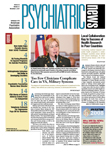On October 9, American neuroscientists and legal experts came together in the Daniel Patrick Moynihan United States Court House in New York City to launch the Law and Neuroscience Project.
The project constitutes one of the first systematic efforts in the United States to bring the worlds of neuroscience and law together in an effort to determine where neuroscience informs the legal process and where it probably doesn't have anything to say.
The project will be financed by an initial three-year, $10 million grant from the John D. and Catherine T. MacArthur Foundation. It will be headed by Michael Gazzaniga, Ph.D., director for the SAGE Center for Study of Mind at the University of California, Santa Barbara. Former Supreme Court Justice Sandra Day O'Connor is honorary chair of the project. One of the members of the project's governing board is Stephen Hyman, M.D., a former director of the National Institute of Mental Health and now a professor of neurobiology at Harvard University.
Not long ago, “we did a search to find out how often neuroscience is used in current court cases,” Gazzaniga told Psychiatric News. She and her colleagues identified 916 cases on dockets throughout the country. The cases concern questions such as whether brain scans can divulge culpability, whether psychological pain can be measured objectively, what is the impact of punishment severity, and what kind of culpability should be applied to people who are addicted. During the project's first year, its members will focus on such questions, and during the second and third years they will conduct research to answer some of them.
Moreover, they plan on developing guidelines for the legal profession on subjects such as the determination of competency and culpability and treatment for psychopaths or persons determined to be criminally insane. They also aim to develop a primer for judges and lawyers that will give a quick reference to neuroscience subjects that might arise in court proceedings—for example, addiction, impulsivity, lies, memory, prejudice, psychopathy, and the use and limits of different kinds of brain scans.
What are several of the major challenges that the project members will face? “I think nailing down the specifics on all of these issues and determining which questions can be answered with current technology and which cannot,” Gazzaniga stated. For example, she noted, can lies be detected with brain scans or electrophysiological methods, and can people really make deliberate, totally conscious choices?
“The legal system assumes that people make deliberate choices and what we choose determines what we do,” Walter Sinnott-Armstrong, Ph.D., a professor of legal studies at Dartmouth College and a project member, said in a prepared statement issued in conjunction with the October 9 conference.“ However, neuroscience indicates that our choices sometimes are based upon electrical impulses and neuron activity that are not part of conscious behavior.” If this contradiction can be resolved, it would impact not just criminal guilt, but also decisions made by police, prosecutors, or jurors to arrest, prosecute, or convict, Sinnott-Armstrong suggested.
“Neuroscience could have an impact on the legal system that is as dramatic as DNA testing,” MacArthur Foundation President Jonathan Fanton predicted.
As information is collected and analyzed, it will be posted on the project's Web site and reported at public conferences. The project will also arrange several weekend retreats each year so that judges, lawyers, legislators, and opinion leaders can learn the basics of neuroscience and its application to the law.
More information about the Law and Neuroscience Project is posted at<www.lawandneuroscienceproject.org>.▪
